Monorail History
This page contains what we consider to be some of the most significant Monorails in History from 1825 to 1964 and is in no way a comprehensive list of monorail history. Visit our Links Page and Wikipedia's monorail page for more fascinating monorails from the past.
The First Monorails
1825 - Cheshunt Railway

The first passenger carrying monorail celebrated a grand opening June 25th, 1825. It had a one-horse power engine...literally. Based on a 1821 patent by Henry Robinson Palmer, the Cheshunt Railway was built to carry bricks, but made monorail history by carrying passengers at its opening.
1876 - Philadelphia Centennial

General Le-Roy Stone's steam driven monorail was first demonstrated at the United States Centennial Exposition in 1876. The ornately designed double-decker vehicle had two main wheels, the rear one driven by a rotary steam engine.
1876 - Sonoma Prismoidal
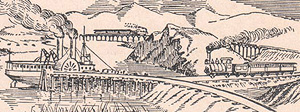
This 7-mile wooden monorail was proposed to be the first rail line built to connect the Northern California city of Sonoma with a steam ship landing at San Pablo Bay. Only three and a half miles were built, between Norfolk and Sonoma. The line operated from November 23, 1876 to May 5, 1877. The company went into bankruptcy that year. The track was 15 inches high and cost $4,500 per mile to build, half the cost of narrow guage railroads of the time. Promoter Joseph S. Kohn's plans to extend it to Sonoma Landing on the Petaluma River were never realized. Kohn also proposed an elevated prismoidal rail for San Francisco along Market Street, but land owners along the line objected.
1878 - Bradford & Foster Brook Monorail

A modified version of General Stone's Centennial monorail was put into use on a 6.4 kilometer line between Bradford and Gilmore, Pennsylvania. It was built to transport oil drilling equipment and personnel to Derrick City. Wayside stations were added at Tarpot, Babcock's Mill and Harrisburg Run. At that point, local inhabitants began to ride the line. The rotary engines lacked power and it was decided to gamble on a much larger locomotive driven by conventional pistons. The worst disaster in monorail history occurred on January 27, 1879 with this engine. Coupled to a flat car full of officials, the train was run at high speed to demonstrate its capability. The boiler exploded and the train crashed into a creek, killing the driver, fireman and three passengers. The rest were severely injured. The line was abandoned shortly thereafter.
1886 - Meigs Monorail

Captain J.V. Meig's monorail made it as far as having a test track, but the design was so far ahead of its time that it never caught on. Who could have imagined that aerodynamics would be considered as early as 1886?
1886 - Enos Electric Railway
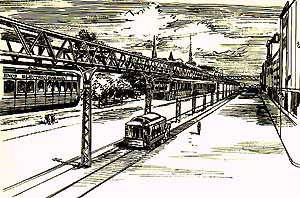
The Enos Electric Railway, the first suspended monorail, was tested and demonstrated on the grounds of the Daft Electric Company in Greenville, New Jersey in 1886. It was built of light, open steelwork rather than massive wooden beams that most monorails to this point had used. The Greenville demonstration attracted considerable publicity in the press, but no major system was ever built. The design may have influenced Eugen Langen in Germany, as the Enos Monorail bears a remarkable likeness to the Wuppertal Schwebebahn in Germany.
1888 - The Listowel & Ballybunion Railway

The Lartigue Railway Construction Company opened a 14.5 kilometer steel-railed monorail on March 1, 1888. It linked the town of Ballybunion, on the west coast of Ireland, with the market town of Listowel. The only passenger-carrying monorail in the British Isles for many years, it ran until 1924. Rising operational costs and road transport forced it out of business.
1901 - Wuppertal Schwebebahn

Civil Engineer Eugen Langen of Cologne, Germany has left his mark on the history of monorails in a big way. His Schwebebahn (suspension railway) has operated successfully along the Wupper river for almost 100 years. It has survived two world wars and continues to operate profitably and safely today. For more photographs and a full-length article, see our Links page.
1909 - Brennan Monorail

Louis Brennan patented his invention for a gyroscopically-balanced car in 1903. A full scale demonstration was presented to the press on November 10, 1909 at Gillingham, England. It was built primarily as a military vehicle due to the high speed at which track could be laid. Even with passengers all on one side of the vehicle, the two onboard gyroscopes were strong enough to keep the car level. Despite a series of successful demonstrations to scientists, engineers and military officers, the fear that the gyroscopes might fail prevented Brennan's invention from ever being used for transportation.
1911 - William H. Boyes Monorail

This test track was built and demonstrated in 1911 in the tideflats of Seattle, Washington. The rails were made of wood and track cost was estimated to be around $3,000 per mile. A bargain! The Seattle Times commented at the time that "the time may come when these wooden monorail lines, like high fences, will go straggling across country, carrying their burden of cars that will develop a speed of about 20 miles per hour." Like so many inventions, lack of financial backing prevented further development.
1914 - Genoa Monorail

Built for the 1914 "Esposizione Internazionale di Igiene, Marina e Colonie" exposition, this straddle-type monorail looks like a close cousin of many of today's Alweg-based monorails. The "Telfer" Monorail had coaches the size of railway cars and was conceived as a mass transit system demonstrator. The line linked the exhibition site with a central square of the city. The train was built by the Italian manufacturer Carminati & Toselli and consisted of 4 coaches for passengers, with an electric locomotive located in the middle. The monorail only operated for a couple of years and was then dismantled.
1924 - The Magnesium Monorail

One of the last Lartigue-based monorails was built by the Sierra Salt Corporation. It carried magnesium salts from their mine in the Crystal Hills to the Trona railhead in California. The route lay across the rugged terrain of the Saline Valley in Inyo County. The line was a great success until more modern ways of extracting magnesium put the mine company out of business two years later.
1929 - The Bennie Railplane

While railroad engineering stagnated between the world wars, one unique demonstation line was built by Scottish engineer George Bennie. The short test track was built over a railroad line near Glasgow, Scotland. Two electrically-powered propellers delivered 240 horsepower in a short burst for acceleration to the cruise speed of 160 kph. There were plans for a high-speed link between London and Paris, with a seaplane to carry passengers across the English Channel, but the grave economic difficulties of the 1930's doomed the Railplane from the start.
Monorails of the Modern Era
1952 - ALWEG Monorail

Swedish industrialist Dr. Axel Lennart Wenner-Gren was the first to build a monorail test track after World War II. Wenner-Gren's first system design was geared more towards a high-speed city to city rail system. Seen here is the scaled-down train which attained speeds near 160 km on an oval test track in Fuhlingen, Germany. While impressive in speed and banking capabilities, the ALWEG system didn't find its niche until a later version was developed and unveiled in 1957 (see below).
1956- Skyway Monorail

Monorail, Incorporated built a short test track of their suspended system at Arrowhead Park in Houston, Texas. Each bogie was powered by a 310-horsepower Packard automobile engine. The driver was seated high above the passenger carriage on one of the two bogies. After eight months of testing, the track was dismantled and rebuilt at the Texas State fairgrounds where it ran for many years. Its promoters claimed it could reach speeds of 160 km but no Skyway transit installations were ever built.
1957 - Ueno Zoo

Japan in the 1950's was in an all-out effort to improve its transportation systems. The first Japanese monorail debuted at Tokyo's Ueno Zoo in 1957. Basically a modern version of Wuppertal's system, the Ueno line used off-the-shelf parts including rubber tires. Japan would later adopt the Alweg and Safege monorail systems and build more transit monorails than any other country in the world.
1957 - ALWEG Monorail
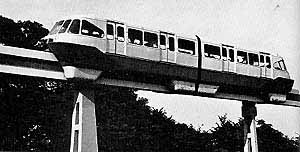
Based on knowledge gained from the original test track of 1952 and subsequent modifications, ALWEG unveiled what has become the most successful monorail system in July of 1957. Located at the same Fuhlingen test sight, this was ALWEG's first full-scale monorail. It caught the attention of Walt Disney, which resulted in the world's attention to the design after Disneyland opened their ALWEG monorail in 1959. Today ALWEG-based systems exist all around the world and many more are in the works.
1958 - SAFEGE Monorail

In 1947, the eminent French bridge builder Lucien Chadenson became interested in the Bennie Railplane experimental line. Also impressed by the Paris Metro Route 11, which uses rubber tires, he decided to combine the two principles. The result was a suspended monorail in which the bogies are protected from weather conditions inside a steel or concrete box-beam above the train. The test track operated for many years in Chateauneuf, south of Paris. Film buffs may recognize it from the sixties classic "Fahrenheit 451." Curiously, the French have never used the system, but the Japanese have built two successful Safege lines. The Siemens Company of Germany has developed a smaller scale system similar to the SAFEGE Monorail. Aerorail of Texas and Sky Train of Florida are promoting steel-wheel versions of SAFEGE as well.
1959 - Disneyland/Alweg Monorail

No monorail in history captured the attention of the public quite like Walt Disney's Alweg Monorail did when it opened in 1959. The result would be the unfortunate type-casting of monorails being "theme park rides," except in Japan. Later versions of the Disneyland monorail improved on the Alweg system and in 1971 a larger dual-rail system was built in Florida at Walt Disney World. A full-sized Alweg monorail was also built for the Tokyo Disneyland Resort area in the 1990s.
1961 - Turin, Italy

In July 2, 1961, TMS member Albert G. Nymeyer took this picture of the first full scale non-test track Alweg line. It ran at Italia 61, which celebrated Italy's national centenary. Over one and a half million passengers traveled on the line for the short period of the fair. Plans to operate the monorail on a permanent basis and extend it to Moncalieri never came to fruition.
1962 - Seattle

The first dual-rail Alweg line opened for the 1962 World's Fair in Seattle. It remains there today. In the 1990s and early 2000s Seattle voters supported an expanded monorail system for the city four times. The project was cancelled in 2005 after the Mayor and Council withdrew support and financing became controversial.
1962 - Nihon/Lockheed Monorail
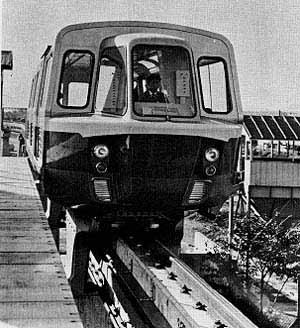
This unique system was invented in the USA and built at a test track in Gifu, Japan. While actually being selected for both Seattle and Tokyo, Alweg later won out for those milestone monorails. The Lockheed design is similar to Alweg in that it uses a concrete beam, but the track and wheels are steel. Two were built for transportation in Japan, yet they no longer operate.
1964-1965 AMF New York World's Fair
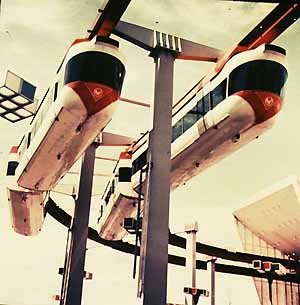
In an effort to promote their Safege licensed monorail, AMF installed and operated a one-station I-Beam monorail for the two-year New York World's Fair. The dual-rail system looped around the amusement area. An earlier Disney monorail plan to surround the entire fairgrounds was rejected, probably due to a much higher price tag. While AMF never sold or built any Safege Monorails, this installation was responsible for many of today's enthusiasts first ride on monorail.
1964 - Tokyo/Haneda Monorail

We end with the monorail that began the modern era of transit monorails. The Tokyo/Haneda Monorail was the first major system to incorporate the Alweg design and use switches for direction reversal. It continues to operate safely and at a profit today.
